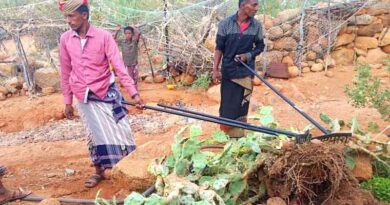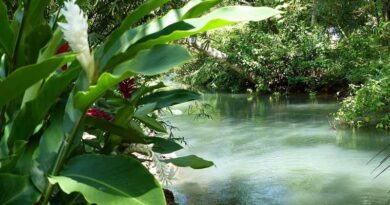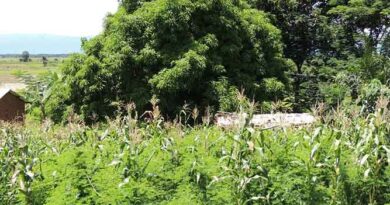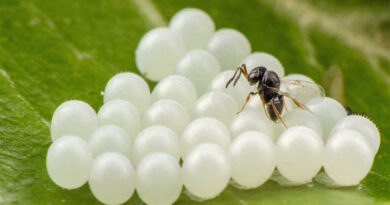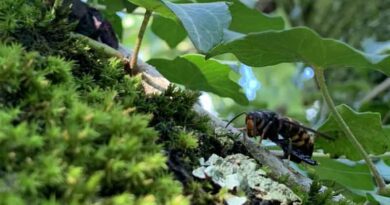CABI and Malawi Government publishes guide to the naturalized and invasive plants of Malawi
14 May 2024, Malawi: CABI has published a ‘Guide to the Naturalized and Invasive Plants of Malawi’ – a country home to the UNESCO World Heritage site, Lake Malawi, the fifth largest freshwater lake in the world by volume and home to around 700 species of cichlids.
The guide, written by Dr Arne Witt, CABI’s Invasives Coordinator, South, and co-authored by Jamestone Kamwendo and Dr Elizabeth Mwafongo, provides detailed descriptions of roughly 115 exotic, non-native or alien plant species (some may have an uncertain origin) which are either naturalized or invasive already or which are deemed to have the potential to become invasive in Malawi and/or its western neighbour Zambia.
Profiled species
The profiled species include two invasive grass species; two invasive fern species, one of which is native; aquatic invasive plants or waterweeds (5 species); vines, creepers, or climbers (11 species); terrestrial herbs, shrubs, and succulents (more than 65 species of each), and trees (more than 25 species).
The collated list includes 138 species but excludes many ruderal and agricultural weeds. Inclusion of these species may well bring the total number of naturalized and invasive alien plants in these two countries closer to 200.
The guide was developed by CABI, in collaboration with the Environmental Affairs Department of the Government of Malawi and the Malawi Herbarium and Botanic Garden, and includes line drawings, colour images and distribution maps.
Some of the most problematic invasive plant species in Malawi and Zambia include the perennial aromatic shrub Lantana camara, Chinese mint (Hyptis suaveolens), Mexican sunflower (Tithonia diversifolia) and Australian pest pear (Opuntia stricta).
The list also includes several species in the genus Senna; apple of Sodom (Calotropis procera); large cocklebur (Xanthium strumarium); Spanish clover (Desmodium uncinatum); guava (Psidium guajava), and bellyache bush (Jatropha gossypiifolia).
Rich in wildlife and plant species
Malawi is rich in wildlife and plant species, including lions, leopards, elephants, rhinos, and buffalo. Lake Malawi is also home to more species of fish than any other lake including cichlids such as Utaka, Mbuna and Mcheni.
Meanwhile, Mount Mulanje boasts 69 endemic plant species; and the Nyika plateau harbours over 200 orchid species.
But the myriad of native species present in Malawi is threatened by, among others, the uncontrolled spread of Invasive Alien Species (IAS) which are also eroding the natural resource base on which millions of people depend.
One of the major barriers to effective IAS management is the lack of information on the presence, distribution, impact, and management of invasive species.
Serious threat to biodiversity, livelihoods, and economic development
Dr Witt said, “Invasive alien species pose a serious threat to biodiversity, livelihoods and economic development in Malawi and neighbouring Zambia. Yet the management of invasive species in both countries, and of invasive alien plant species, is constrained by several factors.
“These include weak policies or poor implementation of policies pertaining to IAS management; lack of awareness and of access to critical information, particularly on the presence, distribution, impacts and management of IAS; inadequate resources available for effective prevention and control, and a general lack of capacity.
“This guide is intended to give Malawi and Zambia the information they require, in order to be able to develop effective strategies for combating the existing and rapidly increasing menace posed by invasive alien plants.”
Managing shared invasive plant species
Dr Witt added that it is hoped the guide will foster increased collaboration between Malawi and Zambia, and possibly also other countries in the region, especially in responding to the challenges of managing shared invasive plant species.
“As such it is hoped that the Guide will contribute to increased collaboration across all the SADC regions. In fact, the SADC Secretariat has highlighted the significant threat that IAS pose to economic development in the region,” Dr Witt said.
The guide was funded by the Global Environment Facility (GEF) whose remit includes providing grants and finance for projects related to, amongst others, biodiversity, climate change, land degradation, sustainable forest management and food security.
It has been developed to help address this issue as one of the outputs of the UNEP-GEF Project “Enhancing sustainability of Protected Area systems in Malawi and stabilizing agro-production in adjoining areas through improved IAS management.”
Dr Yusuf M. Mkungula, Secretary for Natural Resources and Climate Change at the Malawian Government, said, “The guide will contribute significantly to increasing awareness and building capacity about the threat invasive species pose to sustainable development.”
Dr Mkungula added that the guide will also contribute to Malawi meeting its obligations under various international agreements and treaties, such as the Convention on Biological Diversity (CBD) and the International Plant Protection Convention (IPPC).
“Improved management of invasive plants will also contribute significantly to Malawi achieving its Sustainable Development Goals,” he said.
(For Latest Agriculture News & Updates, follow Krishak Jagat on Google News)


